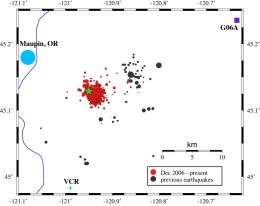Scientists Study Earthquake Swarm Near Maupin

(������ƵOrg.com) -- During the last two years more than 350 small earthquakes have been recorded just outside the small eastern Oregon town of Maupin and scientists are unsure what is triggering the activity.
The earthquakes began in December of 2006 and though only a dozen or so of the temblors exceeded magnitude 3.0, the largest of the events could be felt locally. Scientists from Oregon State University presented an analysis of this “earthquake swarm” at the annual meeting of the American Geophysical Union in San Francisco in December.
The earthquakes all originated within a very small area just a few miles southeast of Maupin and about 30 miles southeast of Mt. Hood, according to Jochen Braunmiller, a research associate in OSU’s College of Oceanic and Atmospheric Sciences.
“Seismic activity in eastern Oregon is comparatively rare,” Braunmiller said, “and when it does happen, it seems like it happens in these swarms. More common earthquake activity is to get a main shock and then a number of aftershocks. But these swarms lack a main event and instead are characterized by an ongoing series of small quakes.
“These small earthquakes strike Maupin about every other day on average and one looks a lot like another,” he added.
The largest events were a magnitude 3.9 earthquake on July 14 of this year and a 3.8 earthquake on March 1, 2007. Eleven other events had a magnitude of 3.0 or higher, according to data the scientists analyzed from the Pacific Northwest Seismic Network, which is based at the University of Washington and funded primarily by the U.S. Geological Survey; the Oregon Department of Geology and Mineral Industries is a contributing organization.
Occasionally, Braunmiller said, two or three quakes would occur on the same day, but never more than four. And rarely would more than a few days go by without an earthquake.
“That’s rather unusual,” he said.
A geologic map shows a small fault line near the region where most of the quakes have occurred, though it runs in a direction that doesn’t necessarily mirror the pattern of recorded earthquakes. However, Braunmiller pointed out, the exact origin of the earthquakes can be difficult to pinpoint.
Possible explanations for the quakes vary, scientists say. They could be associated with minor magma-related activity or triggered by fluid movement within the Earth’s crust. Braunmiller said it’s also possible that the seismic activity is an extension of disturbances along the Eastern California Shear Zone that runs roughly parallel to the San Andreas Fault, which is creeping northward at a faster rate than the shear zone, creating geologic pressure that may extend into Oregon.
A similar swarm of earthquakes, though some of them larger, has been taking place in Reno, which also is along the Eastern California Shear Zone. Those quakes are much shallower – about two miles below the surface compared to the 10 mile-deep Maupin events.
The largest instrumentally recorded earthquake in Maupin history was a 4.6 event in 1976 and the region also experienced a similar swarm of earthquakes in 1987. Knowledge about the area’s seismic activity before the first monitors were installed in the 1970s is limited.
The most comprehensive data on the Maupin swarm is from 2007, when the National Science Foundation’s Earthscope program, which has its national office at OSU, deployed a temporary array of seismic monitors throughout Oregon. Additional instrumentation helps scientists better hone in on the origin of individual earthquakes. That equipment since has been moved to other locations – part of a plan to gain better seismic understanding of the entire nation.
Braunmiller, who worked on the project with OSU colleagues Anne Trehu, John Nabelek and Mark Williams, said the seismic activity at Maupin is continuing.
“You think at some point that the earthquakes are done,” Braunmiller said, “but they keep cranking along. It isn’t likely that a major quake will follow, but you can never exclude that possibility. That uncertainty is why we need to do more research.”
Provided by OSU College of Oceanic and Atmospheric Sciences



















